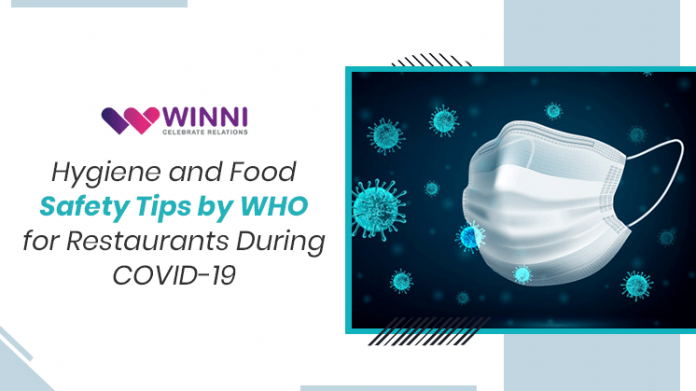The globe is facing an alarming COVID-19 pandemic threat triggered by the SARS-CoV-2 virus. Many nations are adopting the World Health Organization (WHO) advice on implementing physical distancing steps as one of the ways to minimize disease transmission. Working from home, telecommuting, online conversations and meetings are now everyday activities for certain people. However, food industry workers don’t have the ability to function from home, so they are forced to continue to work in their normal workplaces. Keeping all staff safe and healthy in the food processing and manufacturing sectors is key to surviving the global pandemic. Managing the flow of food along the food supply chain is an important task to contribute to all shareholders in the food chain. It is also required to sustain trust and customer interest in food safety and availability.
WHO has been sharing the best practices for the food industry to start functioning during the COVID-19 pandemic. These guidelines are associated with the delivery and pick-up services that will be made during this time. It addresses important concerns as to how retail products should be treated and healthily distributed to the public, as well as important practices for workplace safety, personal protective equipment (PPE), and hygiene & sanitizing.
Here are some guidelines which the whole of the food industry and its employees need to adhere to for a safe workplace.
- If a worker is not feeling well at work, then immediately send them back home. Then you need to clean and disinfect surfaces in your workplace. Those who were close to the employee, i.e., within 6 feet will be considered exposed during this period.
- Inform all the employees that if any of them shows the COVID-19-related symptoms, then they need to report them to their bosses. Advise sick workers to stay at home and observe what to do if you’re sick with 2019 coronavirus disease (COVID-19) from the CDC. For further advice, please check with the local health department.
- If a worker is reported to have COVID-19, then notify fellow workers of their possible exposure to COVID-19 in the workplace, while retaining the privacy of the patient’s information.
- Instruct workers who are safe but know that they have been exposed to COVID-19 to inform their supervisor and obey the precautions suggested by the CDC.
- Implement workspace measures to minimize transmission among employees, such as those listed below in the Interim Guidance for CDC.
For employees:
- Always wear the masks or keep your face covered
- Practice social distancing stay more than 6 feet away from each other
- Keep a check on yourself, i.e., check the temperature and look for the symptoms
For employers:
- Sanitize and clean the workplace with proper pieces of equipment and also keep cleaning the area which is touched regularly
- Pre-screening should be done
Hygiene Tips for Employees
- Please wash your hands with water and soap. If it is not readily available, then use an alcohol-based hand sanitizer with at least 60 per cent alcohol and avoid dealing with unpackaged or raw foods.
- Prioritize proper hand hygiene routine which includes at least 20 seconds of washing hands, specifically after going to the toilet, after blowing your nose, before eating, coughing, or sneezing.
- To use gloves to prevent contact with ready-to-eat products by bare hand.
- Do not touch your mouth, eyes, and nose.
- Keep washing your hands for 20 seconds with water and soap for safety, before cooking or consuming food.
Food Safety Tips for the Restaurants
- Wash, scrub and disinfect the surfaces that come in contact with food such as dishware, utensils, surfaces used for food preparation and equipment used for drinking.
- Make and use the sanitizers for food preparation.
- Keep cleaning surfaces that are regularly touched by the workers or buyers, such as door handles, handles of appliances, check-out counters, and shopping cart handles etc.
- Changes in the food preparation ways such as:
- For later usage, the hot foods are quickly cooled. So, always test the temperature of products being chilled in refrigerators or through cooling methods such as cooling wands and ice baths.
- Cooked foods achieve the correct temperatures before serving or refrigerating.
- Provide proper training to the employees by giving them altered duty timings but ensure that they should know everything
Delivery and Pick-up Service Tips
- Create specified pick-up areas for clients to help keep a social distance.
- Practice social distance when providing food delivery, e.g., offering online cake delivery with “no contact” by sending text messages or calling when shipment arrives.
- Conduct an assessment of your facilities to determine and apply operational improvements to preserve social distance if, where possible, you give take-out/carry-out option by establishing a 6-foot gap from others.
- Maintain the cold and hot foods in proper temperature by storing them in suitable vessels for transport.
- Keep cold foods chilled by keeping them in refrigerant products, such as gel packs.
- Keep hot foods heated up by ensuring the proper working of insulated cases.
- Make sure that all food transport wrapping and packing is completed to avoid contamination of the products.
- Avoid keeping foods together to prevent cross-contamination, such as keeping raw foods apart from cooked meals.
These were the guidelines which the food industry has to follow if they plan to work during the pandemic. Winni is also doing their best to ensure that all the food hygiene tips are appropriately followed for the cake delivery to the allowed locations.




